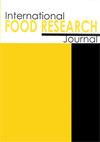采用不同包装薄膜对大白果的呼吸速率进行了模拟
IF 1
4区 农林科学
Q4 FOOD SCIENCE & TECHNOLOGY
引用次数: 0
摘要
大白(Canarium odontophyllum Miq.)是一种营养丰富的水果,在当地和全球都有巨大的销售潜力。然而,由于促销力度不足,导致旺季供过于求,从而降低了其市场价格。因此,正确的处理和包装对于保持大白的质量和延长其保质期是必要的。在本工作中,尼龙薄膜的氧气透过率(OTR)为55 cc/m2/day,水蒸气透过率(WVTR)为334 g/m2/day;聚乙烯对苯二甲酸乙二醇酯(PET)薄膜,其OTR为90cc /m2/day, WVTR为35g /m2/day;采用OTR为8000 cc/m2/day、WVTR为200 g/m2/day的低密度聚乙烯(LDPE)薄膜包装大白,5℃保存14 d。膜的尺寸为200 × 300 mm,厚度为0.01 μm。结果表明,在整个贮藏过程中,大白的色相角(h°)值保持在深紫色区域(299.73°~ 338.64°),亮度(L*)值保持不变。然而,颜色强度(色度)发生了显著变化(p <0.05),不同薄膜在贮存过程中的差异(p <0.05)。对照样品的硬度和重量下降最为显著(p <0.05),然后将样品保存在PET、LDPE和尼龙中。然而,与尼龙和PET相比,LDPE样品的呼吸速率最低。采用非竞争Michaelis-Menten方程模型对大白的呼吸速率进行了建模。结果显示,所有影像均获得了良好的拟合(R2接近于1),平均相对百分比(E%)小于10%,表明数据适合实时应用。本文章由计算机程序翻译,如有差异,请以英文原文为准。
Modelling the respiration rate of dabai fruit (Canarium odontophyllum Miq.) stored in different packaging films
Dabai (Canarium odontophyllum Miq.) is a highly nutritious fruit that has a huge potential to be marketed both locally and globally. However, the lack of promotion leads to an oversupply during peak season, thus reducing its market price. Proper handling and packaging are therefore necessary to maintain the quality and extend the shelf life of dabai. In the present work, nylon film with an oxygen transmission rate (OTR) of 55 cc/m2/day and water vapour transmission rate (WVTR) of 334 g/m2/day; polyethylene terephthalate (PET) film with an OTR of 90 cc/m2/day and WVTR of 35 g/m2/day; and low-density polyethylene (LDPE) film with an OTR of 8000 cc/m2/day and WVTR of 200 g/m2/day were used to pack dabai and stored at 5°C for 14 d. All films had a dimension of 200 × 300 mm, and a thickness of 0.01 μm. It was found that dabai maintained its hue angle (h°) values within the dark purple region (299.73° to 338.64°) and its lightness (L*) values throughout storage. However, the colour intensity (chroma) significantly changed (p < 0.05) between different films throughout storage (p < 0.05). The control sample had the most significant decrease in firmness and weight (p < 0.05) between day 0 and 14, followed by the samples stored in PET, LDPE, and nylon. Whereas the samples in LDPE demonstrated the lowest respiration rate as compared to nylon and PET. The uncompetitive Michaelis-Menten equation model was used to model the respiration rate of dabai. Results showed that all films obtained good fit (R2 of near to 1). Additionally, the mean relative percentage (E%) was less than 10%, thus indicating that the data were suitable for real-time application.
求助全文
通过发布文献求助,成功后即可免费获取论文全文。
去求助
来源期刊

international food research journal
Agricultural and Biological Sciences-Food Science
CiteScore
1.40
自引率
0.00%
发文量
75
期刊介绍:
The International Food Research Journal (IFRJ) publishes papers in English, six (6) issues a year with the coverage of:
Food Science and Technology
Nutrition and Dietetics
Agriculture, multidisciplinary
Chemistry, multidisciplinary
The scope of the Journal includes:
Food Science, Food Technology and Food Biotechnology
Product Development and Sensory Evaluation
Food Habits, Nutrition, and Health
Food Safety and Quality
Food Chemistry, Food Microbiology, Food Analysis and Testing
Food Engineering
Food Packaging
Food Waste Management
Food Entrepreneur
Food Regulatory
Post-Harvest Food Management
Food Supply Chain Management
Halal Food and Management
 求助内容:
求助内容: 应助结果提醒方式:
应助结果提醒方式:


